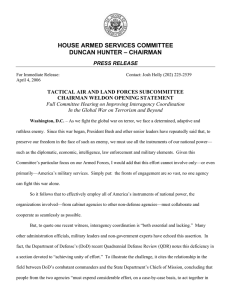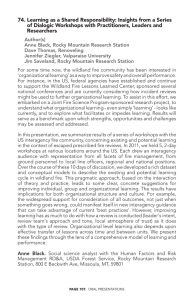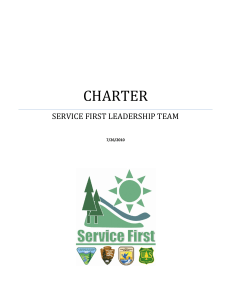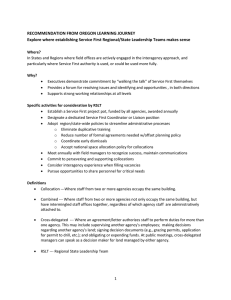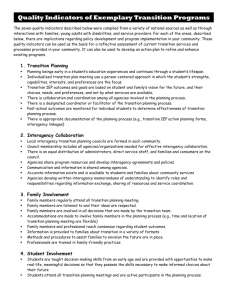Enclosure 3A - Project Summary Form
advertisement
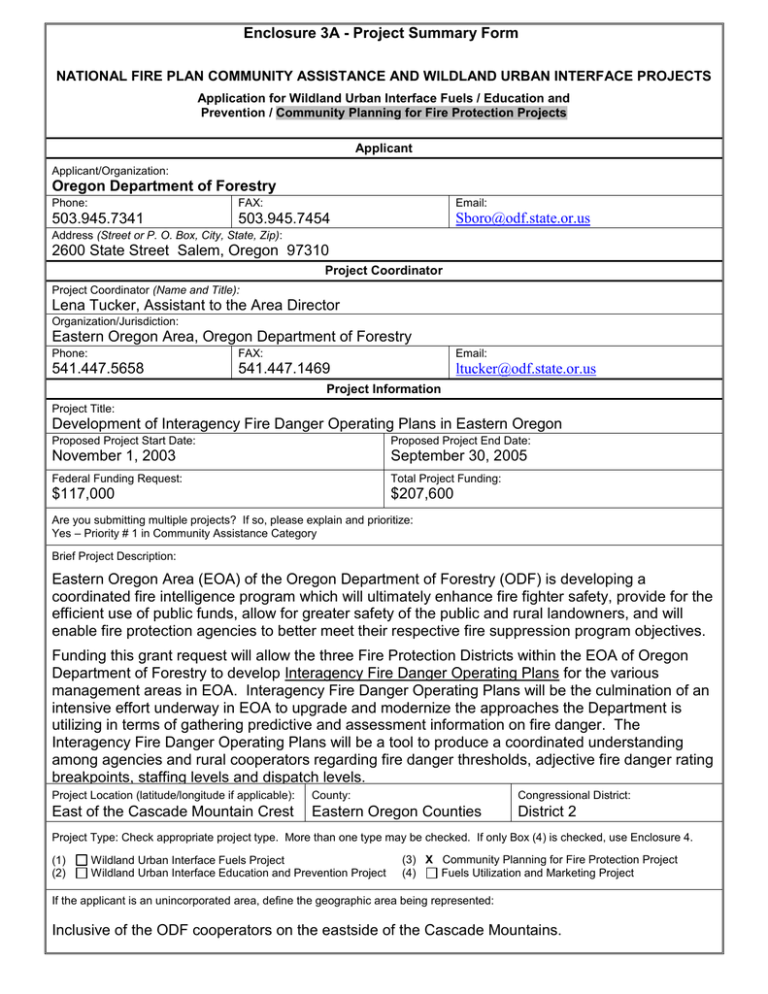
Enclosure 3A - Project Summary Form NATIONAL FIRE PLAN COMMUNITY ASSISTANCE AND WILDLAND URBAN INTERFACE PROJECTS Application for Wildland Urban Interface Fuels / Education and Prevention / Community Planning for Fire Protection Projects Applicant Applicant/Organization: Oregon Department of Forestry Phone: FAX: Email: 503.945.7341 503.945.7454 Sboro@odf.state.or.us Address (Street or P. O. Box, City, State, Zip): 2600 State Street Salem, Oregon 97310 Project Coordinator Project Coordinator (Name and Title): Lena Tucker, Assistant to the Area Director Organization/Jurisdiction: Eastern Oregon Area, Oregon Department of Forestry Phone: FAX: Email: 541.447.5658 541.447.1469 ltucker@odf.state.or.us Project Information Project Title: Development of Interagency Fire Danger Operating Plans in Eastern Oregon Proposed Project Start Date: Proposed Project End Date: November 1, 2003 September 30, 2005 Federal Funding Request: Total Project Funding: $117,000 $207,600 Are you submitting multiple projects? If so, please explain and prioritize: Yes – Priority # 1 in Community Assistance Category Brief Project Description: Eastern Oregon Area (EOA) of the Oregon Department of Forestry (ODF) is developing a coordinated fire intelligence program which will ultimately enhance fire fighter safety, provide for the efficient use of public funds, allow for greater safety of the public and rural landowners, and will enable fire protection agencies to better meet their respective fire suppression program objectives. Funding this grant request will allow the three Fire Protection Districts within the EOA of Oregon Department of Forestry to develop Interagency Fire Danger Operating Plans for the various management areas in EOA. Interagency Fire Danger Operating Plans will be the culmination of an intensive effort underway in EOA to upgrade and modernize the approaches the Department is utilizing in terms of gathering predictive and assessment information on fire danger. The Interagency Fire Danger Operating Plans will be a tool to produce a coordinated understanding among agencies and rural cooperators regarding fire danger thresholds, adjective fire danger rating breakpoints, staffing levels and dispatch levels. Project Location (latitude/longitude if applicable): County: Congressional District: East of the Cascade Mountain Crest Eastern Oregon Counties District 2 Project Type: Check appropriate project type. More than one type may be checked. If only Box (4) is checked, use Enclosure 4. (1) (2) Wildland Urban Interface Fuels Project Wildland Urban Interface Education and Prevention Project (3) X Community Planning for Fire Protection Project (4) Fuels Utilization and Marketing Project If the applicant is an unincorporated area, define the geographic area being represented: Inclusive of the ODF cooperators on the eastside of the Cascade Mountains. Enclosure 3B (Page 1 of 3) - Project Narrative Description Applications for funding must include a narrative response that describes the proposal. Please do not submit responses longer than one page, single space, 12-pitch font. Describe project including, but not limited to: project location Address these project implementation items as anticipated outcomes applicable: measures and reporting interagency partners project relationship to community or natural landscape fire plans project time frames and income specify types of activities and equipment used amount or extent of actions (acres, number of homes, etc) environmental, cultural and historical resource requirements Response: The purpose of the Interagency Fire Danger Operating Plan grant proposal is to develop and provide insightful information to fire decision makers – from firefighters to agency administrators – enabling informed decisions that will accomplish interagency fire management objectives. Firefighter safety, more effective and efficient use of resources, and the resulting lower suppression cost and loss will be the true, long-term benefits. This proposal will provide funding for an ODF fire intelligence specialist located within the three Fire Protection Districts within the Eastern Oregon Area. The funding in this grant will enable the fire intelligence specialist to devote additional time to the development of coordinated Interagency Fire Danger Operating Plans with department fire staff and with our interagency partners. Current budget levels do not contain sufficient funding for the completion of these plans, leaving a gap in interagency fire danger assessment that diminishes firefighter and community safety. All three of the Fire Protection Districts in EOA have developed Interagency Initial Attack Analysis, Fire Danger Pocket Cards and are involved with training concerning the National Fire Danger Rating System (NFDRS). Funding through this grant will enable the department in eastern Oregon to pull together these various predictive and management tools into a comprehensive, coordinated Interagency Fire Danger Operating Plan. These plans will aid the Fire Protection Districts and all of our interagency cooperators in developing coordinated public prevention programs and public-use restrictions and in determining appropriate staffing and dispatch levels. The time frame for this grant will be from October of 2003 to September of 2005. It is anticipated that five to seven Interagency Fire Danger Operating Plans will need to be developed to cover the management areas in the Eastern Oregon Area. The deliverable for this grant will be at least five operating plans across the Area. The department will cost-share this project at approximately 45%. The area covered with this grant is approximately six millions acres of state protected lands and a similar sized land based with cooperating agencies. The Department will coordinate with both federal and non-federal fire protection agencies in the development of the Interagency Fire Danger Operating Plans. The elements within each Interagency Fire Danger Operating Plan will include the following: Identification of roles and responsibilities for field managers, program manager and dispatch centers. A summary of the fire danger rating inventory, including historic fire activity, weather stations, fuels summary, topography, climate class and fire danger rating areas. Fire danger indices. Fire danger based decision guide, which includes daily staffing levels, preplanned interagency dispatching, public prevention and public use restrictions, and industrial restrictions. Operational procedures. Program needs in terms of additional training, equipment and weather station sites. Enclosure 3B (Page 2 of 3) - Project Evaluation Criteria Applications for funding must include narrative responses that address the following four criteria. Within each criterion, subcriteria are listed in descending order of importance. Limit your responses to the areas provided. 1. Reducing Fire Risk. (40 points)) A. Describe how the proposal promotes reduction of risk in high hazard areas or communities, or natural landscapes. B. Describe how the proposed project benefits resources on federal land or adjacent non-federal land, or how it protects the safety of communities. C. To what extent does the project implement or create a cooperative (1) fuels treatment plan or (2) community fire strategy (include evidence of the plan if it already exists)? D. Explain to what extent the affected community or proponent has been involved or plans to involve the affected community in a qualified fuels education program (e.g., FIREWISE). E. Explain how the proposal (1) leads to, enhances or restores a local fire-adapted ecosystem, and/or (2) mitigates or leads to the mitigation of hazardous fuel conditions. F. How will the proposed treatments or programs be maintained in future years? Response: The Interagency Fire Danger Operating Plans will be a planning tool that promotes broad, interagency coordination. By-products of this plan will be the identification of high hazard areas and areas of critical fire concerns. These areas will include wildland-urban interface areas, and areas of high concentration of public values. Firefighter safety and the safety of the public will be enhanced through better training, accurate dispatches, the development of appropriate staffing levels and through firefighter education. Fire prevention activities and approaches will also be identified, communicated and coordinated during plan development. Once completed, the Interagency Fire Danger Operating Plans will be an iterative tool to refine and improve as additional insights, observations and information dictate. A formal, comprehensive review will occur on a six- year basis. 2. Increasing local capacity. (30 points) A. How would the proposal improve or lead to the improvement of the local economy in terms of jobs and sustainable economic activity? How many jobs are expected to be created or retained and for how long (please distinguish between essentially yearround and seasonal jobs)? How will this proposal link to other projects (or proposed projects) to create year-round jobs? B. To what extent will this project be offered to serve as a model for other communities or natural landscapes? C. Will biomass or forest fuels be utilized; if so, in what manner and how much? Response: The development of effective Interagency Fire Danger Operating Plans will enhance the coordination and education of fire fighting personnel across the Area. These plans will provide useful information to decision makers and will promote firefighter safety, more effective and efficient use of resources and will result in lower suppression cost through a reduced cost plus loss concept. Reduced loss will be in terms of less private and federal forest resources destroyed by fire, fewer homes burned, and reduced impacts to commerce during large fire events. Upon completion, these plans will serve as a model to all fire protection organizations throughout the State and Region. Fire danger operating plans will identify appropriate staffing levels, which will in turn dictate adding contingency or severity firefighting forces. Many of these resources are hired within the local community. Enclosure 3B (Page 3 of 3) - Project Evaluation Criteria 3. Increasing interagency and intergovernmental coordination. (15 Points) A. Describe how this project implements a local intergovernmental strategy or plan, or creates such a plan. Describe the plan if it already exists. B. Explain the level of cooperation, coordination or strategic planning through a “Local Coordination Group” for wildland fire activities, or among federal, state, tribal, local government and community organizations. List the cooperators (a detailed list of cooperators will be required for projects that are funded). Response: Funding this grant will create interagency strategies. These plans will develop a consistent and coordinated approach to addressing fire prevention planning, fire suppression responses and firefighter safety. The development of Interagency Fire Danger Operating Plans requires coordination with all the fire protection partners within a given management area. These partners currently exist in every Fire Protection District within EOA. The partners will be many but will include the various National Forests, BLM Districts, some of the USFWS wildlife areas, BIA, Tribal Fire Departments, National Weather Service, and numerous City and Rural Fire Protection Districts. Coordination is an on-going activity in the fire protection business. Funding this plan will enhance this activity and will create a focal point for specific coordination to address interagency fire prevention, fire suppression responses and fire fighter safety. (Specific coordination points and agencies can be provided for each fire danger operating plan prior to the allocations of funds) 4. Expanding Community Participation. (15 Points) A. To what extent have interested individuals, groups, and communities been provided an opportunity to become informed and involved in this proposal? B. Describe the extent of local support or opposition for the project, including any cost-sharing arrangements. C. What are the environmental, social and educational benefits or concerns of the project? Response: Contacts have been made with many of the fire protection cooperators in EOA. Our Federal cooperators have developed agency specific Fire Danger Operating Plans. Interest has been expressed by Federal cooperators to develop Interagency Fire Danger Operating Plans to better describe the true operational picture of the protection system in EOA. These plans will help in the development of a ‘complete and coordinated’ fire protection system for EOA. In addition, contacts have been made with many of the rural fire protection cooperators in EOA. To date, all of these cooperators have expressed interest in going forward with cooperative fire danger operating plans. Educational by-products of this grant will come as a result of the fundamental analysis of historic weather conditions, assessment of fire behavior, and with analysis of historic fires. This thoughtful and thorough review will educate fire managers and will result in more effective fire responses and safer firefighting. This grant is modeled after a funded National Fire Plan grant submitted by Benton Co. #1. Benton Co #1 is located in south central Washington in the Tri-Cities area. Enclosure 3C - Project Work Form Tasks Time Frame Responsible Party Fall of 2003 Interagency Partners with ODF Lead Define Fire Danger Rating Areas Geographic or Administrative Fall/Winter of 2003 Interagency Partners with ODF Lead Determine and review weather station information Representative locations Is data complete Is data accurate Is data consistently collected Winter/Spring of 2004 Interagency Partners with ODF Lead Inventory Area of Concern What outputs are needed? Personnel Safety Improved effectiveness Improved efficiency Recreate Fire Danger History for a Spring/Summer of 2004 Management Area based on NIFMID/ WIMS Merge Fire Danger with Fire Activity Winter of 2004 within a Management Area. Is Fire Activity Data Complete Is an appropriate timetable use Interagency Partners with ODF Lead Determine interagency fire business Winter/Spring of 2004/2005 thresholds? Calculate current fire danger indices Make fire program management Spring/Summer of 2005 decisions Documentable Quantifiable Repeatable Credible Communicate Fire Danger Status Fall of 2005 Develop personnel understanding Safety Considerations Improved Effectiveness Improved Efficiency Interagency Partners with ODF Lead Interagency Partners with ODF Lead Interagency Partners with ODF Lead Interagency Partners with ODF Lead Enclosure 3D Project Budget Cost Category Description Federal Agency Applicant Partner 1 Partner 2 Total 74,405 ODF 59,790 74,405 59,790 31,995 25,710 31,995 25,710 1,000 500 1,000 500 8,600 3,600 Subtotal 8,600 3,600 Supplies Misc. 1,000 1,000 Subtotal 1,000 1,000 2,000 117,000 90,600 207,600 Personnel Fire Intelligence Specialist Subtotal 134,195 Fringe Benefits Subtotal- 57,705 Travel Subtotal Equipment Computers, Printers 1,500 12,200 Contractual Subtotal Other Subtotal Total Costs Project (Program) Income1 (using deductive alternative) 1 Program income is the gross revenue generated by a grant or cooperative agreement supported activity during the life of the grant. Program income can be made by recipients from fees charged for conference or workshop attendance, from rental fees earned from renting out real property or equipment acquired with grant or cooperative agreement funds, or from the sale of commodities or items developed under the grant or cooperative agreement. The use of Program Income during the project period may require prior approval by the granting agency.
